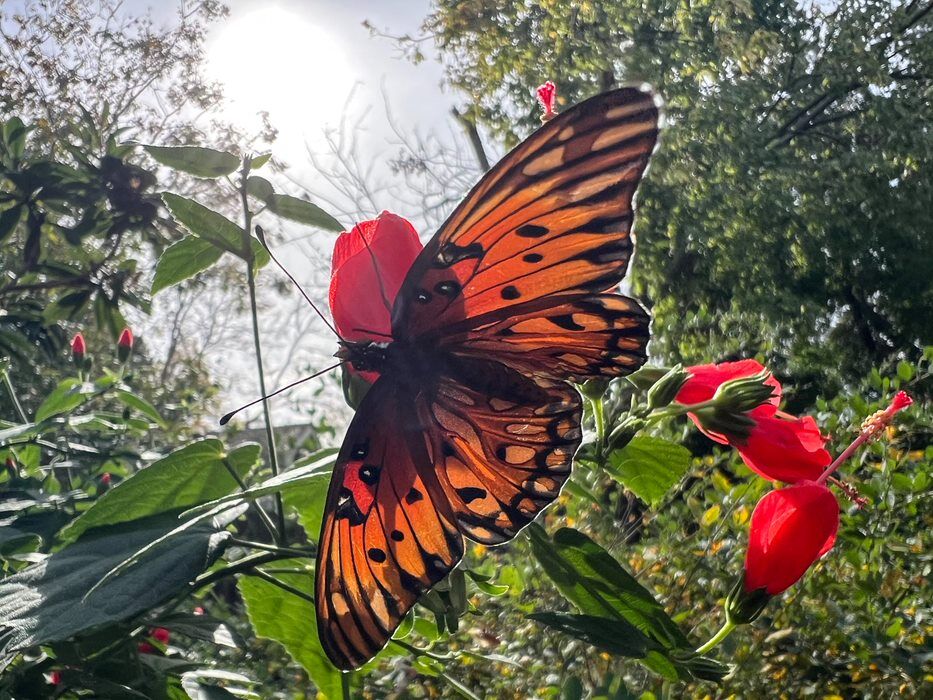Float like a butterfly – Attracting Native Pollinators
Published 12:30 am Thursday, April 11, 2024

- The state butterfly, Gulf Fritillary
Butterfly lovers are aflutter with some of the first sightings, this month, of red admirals, Eastern giant and tiger swallowtails, gray hairstreaks, pearl crescents, gulf fritillaries (our state butterfly) and, a favorite, monarchs.
In Louisiana the butterfly flight season spans from late February to early November, which gives lepidopterists (butterfly lovers) plenty of opportunity to spot the “winged blossoms”- as poet Rudyard Kipling called them. According to Craig Marks, author of Butterflies of Louisiana, there are some 154 species of butterflies in the Pelican state that can be found in backyards and coastal prairies and from swamplands to the pinewoods of North Louisiana.
Once among the most prevalent butterflies in our area, the monarch was placed on the list of candidates as endangered species in 2020. The World Wildlife Federation reported a 59 percent decrease during the 2023/2024 winter season, the second smallest population ever reported, presumably due to pesticide use, disease, habitat loss and diminished food sources. Only 5 percent of monarch caterpillars are reported to reach adulthood because of a decrease in milkweed, the only host plant eaten by the caterpillar.
The more people who plant native milkweed (swamp or aquatic) the more food will be available, and the more returning monarchs can reproduce successfully, ensuring future generations.
Monarch raisers like Helen Holleman-Bayard provide milkweed and a safe haven in hopes to boost the number of butterflies able to make it to Mexico. Each year four generations of monarchs make the 3,000-mile journey, from eastern U.S. and Canada to central Mexico in a relay against strong winds and other treacherous weather conditions.
“The single most important thing I can do to help them is to provide a place where they can eat, rest, lay their eggs, thrive, and move on,” says Bayard, who has raised monarchs since 2021.
She participates in the tagging program of the Monarch Watch Organization which helps researchers determine the migration pathway of the monarchs across North America. From September 16 through October 31, she brings the chrysalis inside her home just before the butterflies are ready to emerge. Shortly after they make their way out, she places a small, lightweight sticker (with an identification number) onto a wing.
“Every one I can save can make a small difference,” says Bayard, who released 20 butterflies last year.
The impact goes beyond helping monarchs. All butterflies are essential pollinators that are vital to the production of about 150 food crops in the U.S.
The key to finding these fluttering beauties is an area with plenty of sunshine and diverse plants and other foods to feed upon. Most adult butterflies feed on nectar, so anywhere there are flowers is a good place to start.
If you want to watch the butterflies gather, include bedding plants like vinca, impatien, petunia, zinnia, sunflowers and salvia. Good herbaceous perennials to include are Pentas, rudbeckia, butterfly bush, coreopsis, daylily, white trailing lantana and verbena.
Different butterflies have their own host plants, which are vital to their life cycle. The sleepy orange butterflies enjoy the nectar of the partridge pea, the gray hairstreaks feed on native hibiscus, pearl crescents like native asters and Eastern tiger swallowtails go for the sweet bay magnolia.
Puddling Stations
Puddling is another way to nourish butterflies (mostly males) by providing them with not only water but essential minerals. You can create a simple puddler using a container 2-3” deep, like a clay water tray. Add sand, compost or mud up to the rim, along with a few rocks for the butterflies to land on, and make sure it stays wet.
Monica and Steve Boutte provide a haven for butterflies and other small creatures in their half-acre backyard which they call Humble Earth Garden. Monica, who has been a member of Louisiana Butterflies and Moth since 2016, has planted host and nectar plants for some 27 years. Their garden, located in Lafayette, is not only a monarch waystation but is a certified butterfly garden through the North American Butterfly Association. Humble Earth is also a certified wildlife habitat through the National Wildlife Federation and most recently became a gold-level Louisiana Certification Habitat through the Louisiana Native Plant Society.
Several times a year, the Acadiana Native Plant Project arranges tours at Humble Earth Garden, with its neat grassy walking paths, water features, sitting areas and 9’x 16’ pond.
Butterfly watching – or raising – is a nature hobby the whole family can enjoy. Most evenings the Bouttes settle onto their backyard deck taking in what they’ve created. “Butterflies are beautiful and fascinating, and each variety has their own personality. They’re like jewelry in the garden,” says Monica.
For a memorable family experience, view a butterfly release at the New Orleans Insectarium.
Create a Butterfly Garden
-Designate an area of at least 100 sq. ft. (It can be broken up into several areas in your yard.)
-Plant in full sun.
-Place your host plants near one another, to create shelter, but don’t overcrowd them.
-Plan your garden to cover each season. For example, monarchs arrive in Acadiana in March, so have milkweed ready then.
-Butterflies are attracted to sound, like windchimes or water gurgling.
-Never use herbicides or pesticides in your yard; it will kill the butterfly larvae. Use ladybugs to handle pests like aphids.
-Support nighttime pollinators by growing flowers that open at night like night-blooming jasmine, smooth hydrangea and moonflower.





